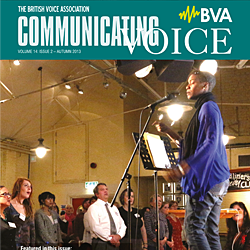About the Association
Archived newsletter articles
Voice Variation with Age/Sex and Cultural and Linguistic Factors
By Evelyn Abberton
'Voice Variation with Age/Sex and Cultural and Linguistic Factors' was the vast topic I was asked to address at the Cotswold Voice Meeting in Cheltenham last April - in 40 minutes! A broad-brush approach was obviously needed but I tried to comment both on impressionistic approaches to describing and labelling voices and on more analytic, quantitative methods.
The framework for my thoughts and observations was that scalar rather than binary terms were useful as voice descriptors, and that Age, Sex, Linguistic and Cultural factors were not separate topics but inter-related. My use of the term 'Voice' was largely restricted to the contribution that the larynx makes in speaking: phonation (vocal registers, voice qualities) and fundamental frequency (pitch) including intonation.
Impressionistic and Physical Descriptions
Phonetic descriptions and labels mix terminology from the different but related points of view of the speaker and the listener: vowels and consonants have both perceptual, auditory (e.g. fricative, plosive), and productive, articulatory (e.g. bilabial, nasal) labels. Voice quality poses a greater descriptive challenge; clinical schemes such as GRBAS and CAPE-V use both production and perception criteria, and in everyday life we make full-blooded use of synaesthesia and imagery: we're all familiar with 'dulcet tones' and 'bright', 'rough' or 'tiny' voices but what does the 'suede-tongued politician' sound like?
Physical, acoustic measures of voice parameters correlate with perceptual features but we should not necessarily expect simple or direct relationships. Fundamental frequency correlates well with our perception of pitch and can be used to measure the average pitch or pitch range of speakers provided that an octave rather than a linear frequency scale is used to take account of our inter-speaker perceptual normalisation ability. Measures of temporal irregularity of successive vocal fold vibrations are related to our perception of vocal roughness (creaky voice, diplophonia); and a measure of variability in the length of the closed phase in successive vocal fold vibrations correlates with our perception of breathiness and 'projection' or strength of a voice: the longer the closed phase, the greater the carrying power of the voice.
Aspects of Voice Variation with Age
Voices of older speakers have been described impressionistically, and certain parameters measured, and comparisons made with younger voices. It seems that listeners are quite accurate in estimating speaker age from audio recordings:- judgments from continuous speech are more accurate than those based on sustained vowels, but not random even for whispered vowels. Young listeners may be more accurate than older, and female listeners more accurate than male; and the ages of younger speakers are more accurately identified. Certain characteristics are considered typical of 'old' voices: lower pitch, regardless of gender; increased perceived strain; a higher incidence of voice breaks; vocal tremor; increased breathiness; slower speech rate and greater hesitancy, and less precise articulation. As far as pitch is concerned, the general trend is for fundamental frequency to lower throughout life with perhaps a rise in the eighth and ninth decades. For males there is the very obvious lowering of average pitch at puberty, and for females hormonal factors can affect the pitch and quality of the voice: pre-menstrual dysphonia, pregnancy, the menopause, the contraceptive pill and Hormone Replacement Therapy. Smoking lowers fundamental frequency and increases roughness at all ages.
Inter-speaker variability is seen at all ages and particularly for older speakers, but it is difficult to disentangle factors associated with normal healthy aging and those due more to health, fitness and occupational factors. For example, breathiness at higher pitches is a characteristic of some (but by no means all) young women. However, older women may have less air escape and longer vocal fold closure phases; this may be due to oedema in some cases or to 'good habits' of occupational voice use and auditory self monitoring in others, with good voice projection maintained throughout the pitch range.
It was a sign of the times that just before the Cotswold meeting the 'Voice Lift' aesthetic surgery had been announced in the media, involving injections of fat or collagen, or using Goretex, to plump up the vocal folds and 'take a voice that is soft and breathy and give it strength and solidity that makes it sound more believable and younger.'
A Few Remarks on Male-Female Variation
Listeners can nearly always identify the sex of a speaker without visual clues - even of very young children. Female speakers typically have higher pitched voices than males, but simply lowering the pitch does not make a female voice sound masculine: breathiness, nasality, formants (resonances of the vocal tract) and loudness may need to be changed. There is an impression that male and female speakers differ in their systematic use of pitch and rhythm patterns but there has been very little work investigating these assumed male-female intonation differences and their psychosocial implications. Contrary to perceived wisdom, female speakers do not have wider pitch ranges than males - if measured using the perceptually appropriate octave/semitone scale; and listeners' interpretations of intonation are influenced by context and expectations.
Cultural and Linguistic Factors
Our descriptions and opinions of the sound of foreign languages and social and regional accents of our own are full of prejudice and stereotypes. We blithely describe German as 'guttural' and Danish as 'a throat disease', and are delighted with the 'melodious, singing' quality of Italian! Urban and rural accents of British English are similarly liked or despised. Very little has been published on voice quality and intonation in this context but they clearly play a role in people's perception of, for example, RP as showing 'the strangulated tones of the upper classes', but nevertheless sounding authoritative. Work on some British urban accents is described in Foulkes and Docherty (Eds.) (1999). One study shows that in Edinburgh there are clear differences in male voices correlating with social class: male working class voices are said to be 'predominantly whispery and harsh', with 'much more creak' in 'higher class' voices. In Glasgow, voice quality differs with age, gender and class but creak does not appear to correlate with class as it does in Edinburgh: men had more creaky voice and women more whispery voice.
Women's voices are expected to conform to cultural stereotypes: westerners have often been struck by the high pitched voice used by young Japanese women when addressing powerful men and interpreted this as a sign of submissiveness. Graddol and Swann (1989) refer to the experience of a Chinese girl in America: 'Normal Chinese women's voices are strong and bossy. We American-Chinese girls had to whisper to make ourselves American feminine'! Do Europeans consider the stereotypical American woman's voice to be whispery?
Our voices change depending on who we are speaking to. A striking example of this is heard in Child Directed Speech (a style also sometimes used when speaking to household pets). The following are frequently noted for English: higher than usual average pitch, in both men and women; wide pitch range (top end of the usual range extended); preference for rising intonation patterns; words emphasised through use of loudness and pitch prominence; slow clear speech with pauses; and use of falsetto, creaky voice and whispering.
In conclusion, our voices provide large amounts of indexical (speaker-characterising information).
Physiological, psychological, social and linguistic factors interact and much more detailed work remains to be done!
More archived content online
Disclaimer
Neither the British Voice Association nor the Editor can be held responsible for errors or any consequences arising from the use of information contained in its newsletters (or extracts from its newsletters published online); the views and opinions expressed do not necessarily reflect those of the British Voice Association (BVA) or the Editor, neither does the publication of advertisements constitute any endorsement by the BVA or Editor of any products or services featured.

 Join us Now!
Join us Now! our newsletter
our newsletter free voice care leaflets & information – download here
free voice care leaflets & information – download here Help our work by donating while you shop
Help our work by donating while you shop